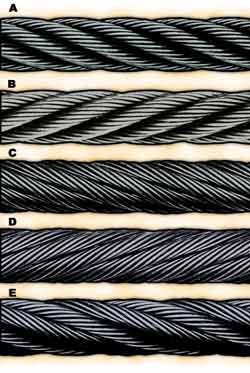
Figure
1. Comparison of Typical Wire Rope Lays:
A) Right
Hand ordinary lay,
B) Left Hand ordinary lay,
C) Right Hand Lang's Lay,
D) Left Hand Lang's lay,
E) Right Hand alternate lay
Wire rope forms an important part of many machines and structures. It is comprised of continuous wire strands wound around a central core. There are many kinds of wire rope designed for different applications. Most of them are steel wires made into strands wound with each other. The core can be made of steel, rope or even plastics.
Wire ropes are identified by several parameters including size, grade of steel used, whether or not it is preformed, by its lay, the number of strands and the number of wires in each strand.
 |
|
Figure
1. Comparison of Typical Wire Rope Lays: B) Left Hand ordinary lay, C) Right Hand Lang's Lay, D) Left Hand Lang's lay, E) Right Hand alternate lay |
A typical strand and wire designation is 6x19. This denotes a rope made up of six strands with 19 wires in each strand. Different strand sizes and arrangements allow for varying degrees of rope flexibility and resistance to crushing and abrasion. Small wires are better suited to being bent sharply over small sheaves (pulleys). Large outer wires are preferred when the cable will be rubbed or dragged through abrasives.
There are three types of cores. An independent wire rope core (IWRC) is normally a 6x7 wire rope with a 1x7 wire strand core resulting in a 7x7 wire rope. IWRCs have a higher tensile and bending breaking strength than a fibr
e core rope and a high resistance to crushing and deformation.A wire strand core (WSC) rope has a single wire strand as its core instead of a multi
-strand wire rope core. WSC ropes are high strength and are mostly used as static or standing ropes.Wire ropes also have fibr
e cores. Fibre core ropes were traditionally made with sisal rope, but may also use plastic materials. The fibre core ropes have less strength than steel core ropes. Fibre core ropes are quite flexible and are used in many overhead crane applications.The lay of a wire rope is the direction that the wire strands and the strands in the cable twist. There are four common lays: right
hand lay, left hand lay, lang's lay and alternate lay. In a right hand lay rope the strands twist to the right as it winds away from the observer. A left lay twists to the left. A regular lay rope has the wires in the strands twisted in the opposite direction from the strands of the cable. In a lang's lay rope, the twist of the strands and the wires in the strands are both twisted the same way. Lang lay ropes are said to have better fatigue resistance due to the flatter exposure of the wires, however are not good in a situation where both ends of the rope are not secured as there can be a tendency for a lang's lay rope to become un-twisted.